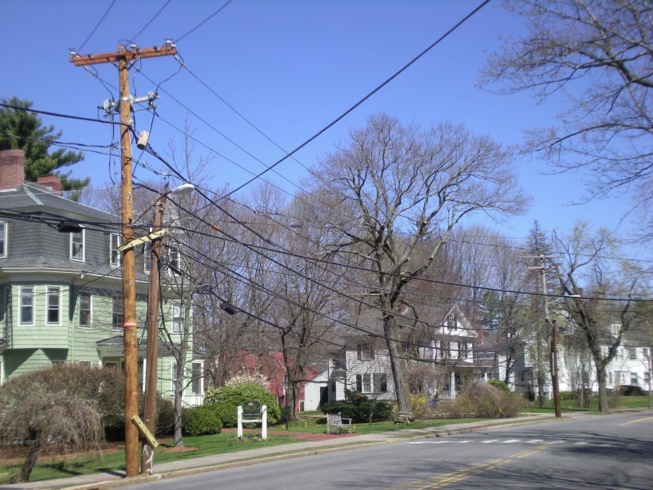
Massachusetts Ave, Lexington, MA, April 2012: the double poles at #2013 (right) and #2027 (left)
are respectively over 5 years old and less than 6 months old
Double poles are created when a utility pole must be replaced because it is too short to serve the growing demand for electricity, may collapse or is damaged.
After all wires and equipment (transformers, cable TV repeaters, streetlights, etc) have been transferred from the old to the new pole -- starting at the top (electric wires) and ending at the bottom (telephone wires) --, the old pole can be removed.
State law (MGL Chapter 164, section 34B) requires this process to be completed in 90 days, but without fines for double poles older than 90 days.
Pole owners (the local electric and/or telephone company) leave hundreds of thousands of double poles for months or years across Massachusetts. No reliable count exists of double poles violating the 90-day limit because the utilities’ PLM database (Pole Lifetime Management), started in 2003 to address this problem, is incomplete.
In Lexington, MA the Lexington Electric Utility Ad-hoc Committee surveys double poles across the whole town every 6 months, and checks the double poles it finds against PLM.
138 double poles exist in Lexington as of March 30, 2012 (address and age of each double pole here), of which at least 90 violate the 90-day limit. Specifically:
- 8 double poles are over 5 years old
- 48 double poles are 2-5 years old
- 15 double poles are 1-2 years old
- 19 double poles are 6 months-1 year old
- 48 double poles are less than 6 months old.
During the preceding 6 months, 8 double poles were removed and 48 were added, for a net increase of 40 double poles.
Of PLM’s 111 records for Lexington, 15 are duplicates or not real double poles. PLM lists 96 real double poles, but misses 42 or 30% of all 138 double poles in Lexington.
Peter Bowman, Vice President of External Affairs at Verizon, the company responsible for removing old poles in Lexington, told the Lexington Board of Selectmen on Oct 30, 2006: “I mean I would say that we should [...] in a six-month time period be largely through our backlog of double poles. And I would make that commitment here tonight on the record to move this process, that we will make serious inroads and get at that, that backlog.” (page 34, transcript of public hearing on Verizon’s FiOS license application) 5 years later, this has not happened.
NStar and Verizon (50%-50% co-owners of each utility pole in Lexington) announced on Sept 30, 2003 at a DTE (predecessor agency to DPU and DTC) public hearing a pilot program in Lexington to demonstrate their new PLM-based approach to removing double poles. DTE's Nov 2003 report (Docket 03-87) did not recommend fines for violation of the 90-day limit pending the results of “enhanced pole owner reporting requirements and use of the PLM system.”
8 years later, PLM misses 30% of all double poles in Lexington, and many double poles still violate the 90-day limit: each week the Lexington Minuteman features one of them, with contact information at Verizon to get it removed. Examples are here, here or here.
We don’t know how munis perform regarding double poles, but unlike IOUs, munis like Marblehead and Concord move wires underground, eliminating poles altogether.
Bills to institute fines for double poles not removed in time are in a sub-committee of the Legislature's Joint Committee on Telecommunications, Utilities and Energy, chaired by Representative Kate Hogan.
